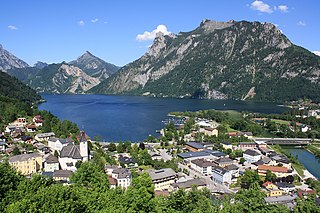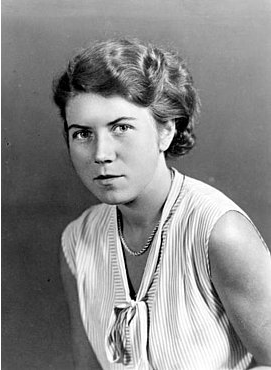
Strobl is a municipality of the Salzburg-Umgebung District (Flachgau), in the northeastern portion of the Austrian state of Salzburg, right on the border with Upper Austria. It comprises the Katastralgemeinden of Aigen, Gschwendt, Strobl, and Weißenbach.

Bad Ischl is a spa town in Austria. It lies in the southern part of Upper Austria, at the river Traun in the centre of the Salzkammergut region. The town consists of the Katastralgemeinden Ahorn, Bad Ischl, Haiden, Jainzen, Kaltenbach, Lauffen, Lindau, Pfandl, Perneck, Reiterndorf and Rettenbach. It is connected to the village of Strobl by the river Ischl, which drains from the Wolfgangsee, and to the Traunsee, into which the stream empties. It is home to the Kaiservilla, summer residence of Austro-Hungarian monarchs Emperor Franz Joseph I and Empress Elisabeth. In 2024, Bad Ischl will be one of the European Capitals of Culture – the third city in Austria after Graz (2003) and Linz (2009).
Josef "Sepp" Plieseis was an Austrian resistance fighter against the Nazi regime.
The Austrian resistance launched in response to the rise of the fascists across Europe and, more specifically, to the Anschluss in 1938 and resulting occupation of Austria by Germany.

Ebensee am Traunsee is a market town in the Traunviertel region of the Austrian state of Upper Austria, located within the Salzkammergut Mountains at the southern end of the Traunsee. The regional capital Linz lies approximately 90 km (56 mi) to the north, nearest towns are Gmunden and Bad Ischl. The municipality also comprises the Katastralgemeinden of Langwies, Oberlangbath, Rindbach, Kohlstatt and Roith.

Maria "Mimi" Terwiel was a German resistance fighter against the Nazi regime. She was active in a group in Berlin that wrote and distributed anti-Nazi and anti-war appeals. As part of what they conceived as a broader action against a collection of anti-fascist resistance groups in Germany and occupied Europe that the Abwehr called the Red Orchestra, in September 1942 the Gestapo arrested Terwiel along with her fiancée Helmut Himpel. Among the leaflets and pamphlets they had copied and distributed for the group were the July and August 1941 sermons of Clemens August Graf von Galen which denounced the regime's Aktion T4 programme of involuntary euthanasia.

Leopold Engleitner was an Austrian conscientious objector, as one of Jehovah's Witnesses, and a concentration camp survivor who spoke publicly and with students about his experiences. He was the subject of the documentary Unbroken Will. Before his death, Engleitner was the world's oldest known male concentration camp survivor, and the oldest male Austrian.

St. Wolfgang im Salzkammergut is a market town in central Austria, in the Salzkammergut region of Upper Austria, named after Saint Wolfgang of Regensburg.

Altaussee is a municipality and spa town in the district of Liezen in Styria, Austria. The small village is nestled on the shores of the Lake Altaussee, beneath the Loser Plateau. Occupying an area of 92 km², Altaussee is home to 1,777 people. The municipality includes two cadastral communities: Altaussee and Lupitsch. The designated climatic spa is within the Salzkammergut region. Altaussee has the biggest salt deposits of Austria, which are still mined today.

Charlotte Bischoff was a German Communist and Resistance fighter against National Socialism.
The Auschwitz Combat Group was international left-wing resistance organization in Auschwitz concentration camp.

Hanna Berger was an Austrian dancer, choreographer, teacher, director, theatre director, writer and lifelong anti-Nazi and communist. She was described as part of the free dance movement.
Luise Kraushaar was a German political activist who became a Resistance campaigner against National Socialism and who also, after she left Germany, worked in the French Resistance. She later became a historian, employed at Berlin's Marxism–Leninism Institute in the German Democratic Republic.
Paula Rueß was a German political activist (KPD). Forced into exile by the Nazi takeover, during the early 1940s she worked with the French Resistance.
Marianne "Mariandl" Feldhammer was an Austrian resistance activist during the Nazi years. She was one of the most important women in the "Willy-Fred" group around Sepp Plieseis. She was the only woman who knew the way to the so-called "Hedgehog" used by anti-Nazi partisans, to which by the end of the war she had herself made several deliveries of food and/or messages.
Rosa Hofmann was an Austrian Communist Youth leader who became a resistance activist during the 1930s. In 1943, she was arrested and taken to Berlin where she faced trial, conviction and execution.
Maria Cäsar was an Austrian political activist (KPÖ) who after the Anschluss in 1938 became a resistance activist. She was among the survivors: during and beyond the occupation years. After the second World War Maria Cäsar played her part in testifying about her experiences of Austria under National Socialism to younger generations.

Elfriede Beate Hartmann was a Viennese chemistry student. Towards the end of 1938, some months after the rapid integration of "Austro-fascist" Austria into a newly enlarged German state under the leadership of Adolf Hitler, she became involved with the Young Communists. After war broke out in 1939 she engaged actively in anti-war resistance. On 22 February 1942 she was caught distributing "leaflets" in a park in Vienna-Döbling and arrested. She faced trial at the special "People's Court" at Krems on 22 September 1943 and was found guilty of "preparing to commit High Treason and Helping the Enemy". She died on the guillotine.
Resi Pesendorfer was an Austrian political activist, close during the 1920s to the Social Democrats. With the abolition of democracy during 1933/34 she became a resistance activist opposing Austrofascism and after 1938, opposing Pan-German National Socialism. She organised a highly effective network of women in the Salzkammergut region, taking a lead in the concealment of increasing numbers of army deserters and others with political records which made them targets for the security services.










